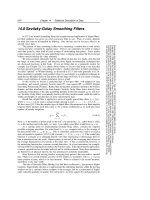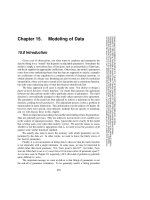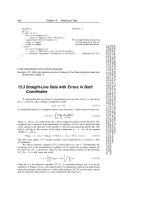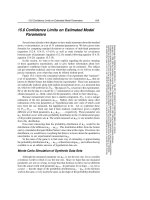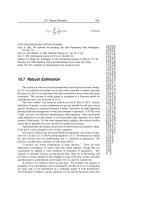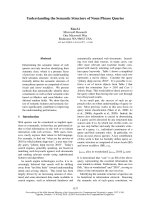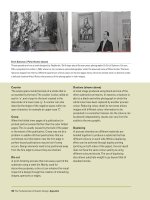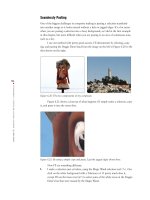THE FRACTAL STRUCTURE OF DATA REFERENCE- P7 ppt
Bạn đang xem bản rút gọn của tài liệu. Xem và tải ngay bản đầy đủ của tài liệu tại đây (211.54 KB, 5 trang )
16 THE FRACTAL STRUCTURE OF DATA REFERENCE
But assuming that the placement of interval boundaries falls at random, the
average number of interval boundaries crossed by front ends and by back ends
must be in proportion to their durations. Therefore, for each touched interval
containing a back end
I/O, there must be, on average, ∆τ/τ touched intervals
that do not. We may therefore conclude that the probability that a touched
interval contains a back end
I/O, and the probability that a touched interval
contains a miss, are both equal to
where the expression on the right follows from (1.11).
the total number of
I/O’s n
req
and touches n
tch
. We may then estimate
To apply the conclusion just stated as a method of trace analysis, we count
(1.17)
Note that if 6’ is in the general ballpark of the guestimate (1.6), then the
estimate (1.17) is not highly sensitive to the exact value of θ being assumed.
For example, suppose that, in some interval, we count a total of 100,000
references to 20,000 distinct tracks. Then the guestimate (1.6) would yield an
estimated hit ratio of 1 – .2 x (1 – .25) = 85 percent. By comparison, the
alternative assumptions θ = .2 and θ = .3 would yield estimated hit ratios of
84 percent and 86 percent respectively.
4.3 REQUIREMENTS FOR MEMORY
We have just devoted several pages to a detailed discussionofthe key, closely
related results (1.1 1) and (1.12), which describe the time spent by a track during
a visit to memory. We now derive what is by far the most important consequence
of this visit time: the resulting cache memory requirements. We relate these
requirements both to the cache miss ratio, as well as to the level of service
being provided to applications (as reflected in the average or single
-
reference
residency time).
Our starting point for calculating the requirements for cache memory is
Little’s law, as applied previously in the result (1.14). The same result can be
stated equivalently as
By (1.4) and (1.12), we also have
(1.18)
(1.19)
where
Hierarchical Reuse Model 17
Substituting this expression for m into (1.18),
(1.20)
In a nutshell, (1.20) says that the requirement for cache memory can be
estimated by first establishing an objective for average cache residency time.
Reasonable objectives for the average residency time, in turn, can be developed
by considering the requirements of individual applications. The next subsection
applies and illustrates these ideas.
It is useful to note that the equations (1.4), (1.12), and (1.20) form a “chain”
that ties together, in succession, the variables m, τ,T,and s. To summarize
the entire “chain” in one place, we have:
(1.21)
where
All of the relationshipsjust presented are sufficiently simple that it is possible
to “skip over” any desired part of the chain through substitution. Also, all of
these relationships are easily reversed. For example, if we wish to express the
cache size requirements in terms of the single
-
reference residency time (rather
than the average residency time as just studied above) we may reverse the last
two equations, then use substitution:
(1.22)
As another example, we can use successive substitutions to express the miss
ratio as a function of cache size. Just as the miss ratio, as a function of the
single
-
reference residency time, takes the form of a simple power law, so does
the miss ratio, as a function of cache memory:
(1.23)
The existence of a power law relationship between these quantities was first
noted by Chow [ 15], and demonstrated convincingly by Smith [ 16].
18 THE FRACTAL STRUCTURE OF DATA REFERENCE
When combined with the guestimate (1.6), and applied in a context where
there is an existing workload with some known I/O rate, (1.23) yields a useful
rule of thumb:
(1.24)
for some (not particularly important) constant k. For example, according to
the rule of thumb just stated, it is necessary to increase the cache size by eight
times, in order to reduce misses by a factor of two.
4.4 AN EMPIRICAL VIEW OF RESIDENCY TIME
As mentioned briefly in introducing the hierarchical reuse model, objectives
for the average residency time T can be developed by considering the require
-
ments of individual applications. In view of (1.20), such objectives provide a
valuable starting point for configuration planning. Let us, therefore, consider
the impact of the average residency time on the performance experienced by a
wide range of cached data.
Figures 1.4 through 1.10 present the performance of a “plain vanilla” cache,
relative to average residency time, for a range of application storage pools.
These include both the VM storage pools already introduced, as well as the stor
-
age pools traced during a survey oftwelve moderate to large OS/390 installations
[ 17]. The figures include the following
OS/390 data pools:
DB2: On
-
line DataBase 2 (DB2) database storage.
Figure 1.4.
time.
VM user storage pools: cache performance as a function ofaverage cache residency
Hierarchical Reuse Model 19
Figure 1.5.
residency time.
VM system storage pools: cache performance as a function of average cache
Figure 1.6.
time.
DB2 storage pools: cache performance as a function of average cache residency
20 THE FRACTAL STRUCTURE OF DATA REFERENCE
Figure 1.7.
time.
CICS storage pools: cache performance as a function of average cache residency
Figure 1.8.
time.
IMS storage pools: cache performance as a function of average cache residency

